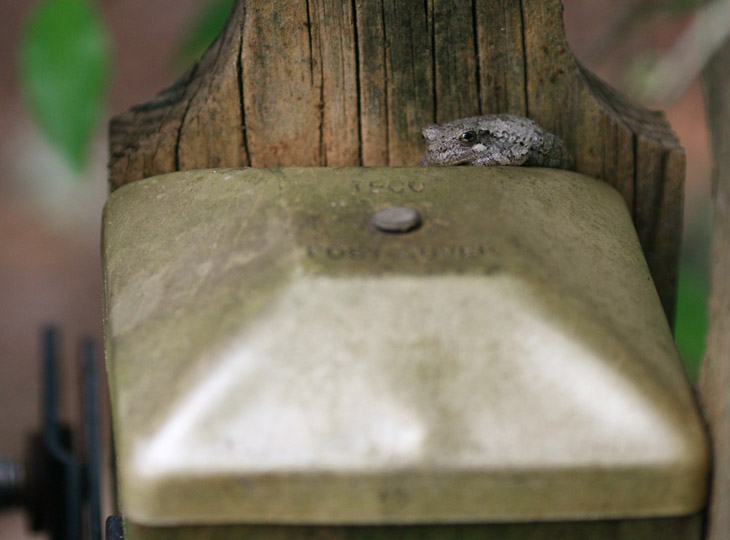
That’s the best reason I can think of for suddenly finding a grey treefrog sitting atop a fencepost two afternoons back, since the active season has passed and I haven’t even been hearing their calls for a while now. But I suspect that, with the temperature dropping to around 15°c (59°f) overnight, the ectothermic amphibian was aiming to warm up a bit and aid its digestion during the day. For some reason, this appears to be a favored perch, insofar as they might be said to have any, because this is the fourth time in a year or so that I’ve photographed one there. Same one? Got me – I consider asking for ID to be intrusive.

The post goes in and out of sunlight throughout the afternoon, but the metal cap might contribute to the heat that it can provide, or maybe the frog just thinks it looks snazzy. I always check, and they never seem to perch in the same place twice on successive nights, though this is on one side of the gate, and last year one was switching sides and locations along the two gateposts for a few days.
This is, I’m fairly certain, a Copes grey treefrog (Hyla chrysoscelis) because that’s the only call I’ve ever heard around here, and the call is the only way to distinguish them short of anatomical examination. More questions arose when I went out front and spotted a much smaller frog perched on the upper leaves of an oak-leaf hydrangea – yes, The Girlfriend and I got a couple to plant in the yard this year. They also go in and out of sun throughout the day, so is a pattern developing?

This one was significantly smaller than the first, sporting a lovely patina of green, and I had to look it up to find out what it was. I’m learning, slowly; that white spot beneath the eye was an indicator and should have clued me in, because this is another grey treefrog – the juveniles often have some green coloration for better protection.
 This one was mellow enough for me to do an effective scale shot, which you can compare with the first by knowing that the fencepost it is perched upon is a 4×4 inch post, so about 9 centimeters square – roughly the size of my palm. Or I could say that while the adult was the length of my thumb, this one was the size of my thumbnail (though that’s my forefinger in the pic.) Totally adorable.
This one was mellow enough for me to do an effective scale shot, which you can compare with the first by knowing that the fencepost it is perched upon is a 4×4 inch post, so about 9 centimeters square – roughly the size of my palm. Or I could say that while the adult was the length of my thumb, this one was the size of my thumbnail (though that’s my forefinger in the pic.) Totally adorable.
I had taken several photos of this one before I even thought to check the second hydrangea nearby, to find another one in a matching position there, and identical in diminutive size. This is enough to make me suspect that we did have a successful brood cycle through the pond I’ve been working on – I’d seen tadpoles on two separate occasions, but never an indication that they had developed farther than that. Guess I’m going to have to watch a lot more closely next year.

This one gives the best idea of the color match and thus the camouflage, despite being right out in plain site on the topmost leaves of the plant – if you only glance at the photo you might not even realize there’s a frog in the frame at all, despite its prominence.
The very first image of the post was taken in natural light, but all the rest were taken with the softbox flash – up until this one. As the sun was lowering in the day, it peeked through the breeze-driven branches to occasionally fall thinly onto the second frog, and I endeavored to capture at least one of these brief light effects.

This gives the most accurate representation of the light conditions, as well as being a nice portrait – I think it’s my favorite frame, at least from a fartistic standpoint.
As the light and temperature fell, the frogs began to get active, and The Girlfriend arrived home too late to see the little ones, though the adult was still close by on another fencepost. I haven’t seen them since. The resident pond frogs are still around though, and I just missed a portrait of the largest when I went out there in the middle of typing this post – they’re quite shy, which is good, because it’ll keep them from getting eaten. I think this made me abandon my plans to clean out the bottom of the pond this winter, because I’m pretty sure I’ll have some frogs nestled down in the mud through the season. I can live with that.




















































